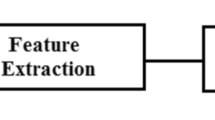Abstract
Laughter frequently occurs in spontaneous speech (e.g. conversational speech, meeting speech). Detecting laughter is quite important for semantic analysis, highlight extraction, spontaneous speech recognition, etc. In this paper, we first analyze the characteristic differences between speech and laughter, and then propose an approach for detecting laughter in spontaneous speech. In the proposed approach, non-silence signal segments are first extracted from spontaneous speech by using voice activity detection, and then split into syllables. Afterward, the possible laughter bouts are constructed by merging adjacent syllables (using symmetrical Itakura distance measure and duration threshold) instead of using a sliding fixed-length window. Finally, hidden Markov models (HMMs) are used to recognize the possible laughter bouts as laughs, speech sounds or other sounds. Experimental evaluations show that the proposed approach can achieve satisfactory results in detecting two types of audible laughs (audible solo and group laughs). Precision rate, recall rate, and F1-measure (harmonic mean of precision and recall rate) are 83.4%, 86.1%, and 84.7%, respectively. Compared with the sliding-window-based approach, 4.9% absolute improvements in F1-measure are obtained. In addition, the laughter boundary errors obtained by the proposed approach are smaller than that obtained by the sliding-window-based approach.
Similar content being viewed by others
References
Bachorowski, J. A., Smoski, M. J., & Owren, M. J. (2001). The acoustic features of human laughter. The Journal of the Acoustical Society of America, 110(3), 1581–1597.
Bickley, C., & Hunnicutt, S. (1992). Acoustic analysis of laughter. Paper presented at the Int. Conf. on Spoken Language Processing, Banff, Canada, 12–16 Oct.
Burileanu, D., Pascalin, L., Burileanu, C., & Puchiu, M. (2000). An adaptive and fast speech detection algorithm. Paper presented at the The Third Int. Workshop on Text, Speech and Dialogue, Brno, Czech Republic, 13–16 Sept.
Cai, R., Lie, L., Zhang, H. J., & Cai, L. H. (2003). Highlight sound effects detection in audio stream. Paper presented at the IEEE Int. Conf. on Multimedia and Expo, Baltimore, MD, USA, 6–9 July.
Carter, A. (2000). Automatic acoustic laughter detection. Unpublished Master thesis, Keele University, Staffordshire, UK.
Dubnowski, J., Schafer, R., & Rabiner, L. (1976). Real-time digital hardware pitch detector. IEEE Transactions on Acoustics, Speech, and Signal Processing, 24(1), 2–8.
Gray, J. A. H., & Markel, J. D. (1976). Distance measures for speech processing. IEEE Transactions on Acoustics, Speech, and Signal Processing, 24(5), 380–391.
Itakura, F. (1975). Minimum prediction residual principle applied to speech recognition. IEEE Transactions on Acoustics, Speech, and Signal Processing, 23(1), 67–72.
Kennedy, L. S., & Ellis, D. P. W. (2004). Laughter detection in meetings. Paper presented at the NIST International Conference on Acoustics, Speech and Signal Processing (Meeting Recognition Workshop), Montreal, Canada, 17 May.
Knox, M. T., & Mirghafori, N. (2007). Automatic laughter detection using neural networks. Paper presented at the Interspeech, Antwerpen, Belgium, 27–31 Aug.
Knox, M. T., Morgan, N., & Mirghafori, N. (2008). Getting the last laugh: automatic laughter segmentation in meetings. Paper presented at the Interspeech, Brisbane, Australia, 22–26 Sept.
Laskowski, K. (2008). Modeling vocal interaction for text-independent detection of involvement hotspots in multi-party meetings. Paper presented at the 2nd IEEE/ISCA/ACL Workshop on Spoken Language Technology, Goa, India, 15–19 Dec.
Li, A.-J., Yin, Z.-G., Wang, M.-L., Xu, B., & Zong, C. Q. (2002). Spontaneous conversation corpus CADCC. Beijing: Phonetics Lab., Institute of Linguistics Chinese Academy of Social Sciences.
Li, Y. X., He, Q. H., Chen, N., & Qi, Z. H. (2008). Spectral stability feature based novel method for discriminating speech and laughter. Journal of Electronics & Information Technology, 30(6), 1359–1362.
Li, Y. X., He, Q. H., Kwong, S., Li, T., & Yang, J. C. (2009). Characteristics-based effective applause detection for meeting speech. Signal Processing, 89(8), 1625–1633.
Makhoul, J., Viswanathan, R., Cosell, L., & Russell, W. (1974). Natural communication with computers: speech compression research at BBN (No. 2976). Cambridge: Bolt Beranek and Newman.
O’Shaughnessy, D. (2008). Automatic speech recognition: history, methods and challenges. Pattern Recognition, 41(10), 2965–2979.
Petridis, S., & Pantic, M. (2008). Audiovisual discrimination between laughter and speech. Paper presented at the IEEE ICASSP 2008, Las Vegas, Nevada, USA, 30 Mar.–4 Apr.
Provine, R. R. (1993). Laughter punctuates speech: linguistic, social and gender contexts of laughter. Ethology, 92, 291–298.
Provine, R. R. (1996). Laughter. American Scientist, 84(1), 38–47.
Rabiner, L. (1989). A tutorial on hidden Markov models and selected applications in speech recognition. Proceedings of the IEEE, 77, 257–286.
Rabiner, L., & Juang, B.-H. (1993). Fundamentals of speech recognition. Englewood Cliffs: Prentice Hall.
Schuller, B., Eyben, F., & Rigoll, G. (2008). Static and dynamic modeling for the recognition of non-verbal vocalisations in conversational speech. In Perception in multimodal dialogue systems (Vol. 5078, pp. 99–110). Heidelberg: Springer.
Temko, A., Macho, D., & Nadeu, C. (2008). Fuzzy integral based information fusion for classification of highly confusable non-speech sounds. Pattern Recognition, 41(5), 1814–1823.
Truong, K. P., & van Leeuwen, D. A. (2007). Automatic discrimination between laughter and speech. Speech Communication, 49(2), 144–158.
Wakita, H. (1976). Residual energy of linear prediction applied to vowel and speaker recognition. IEEE Transactions on Acoustics, Speech, and Signal Processing, 24(3), 270–271.
Author information
Authors and Affiliations
Corresponding author
Rights and permissions
About this article
Cite this article
Li, YX., He, QH. Detecting laughter in spontaneous speech by constructing laughter bouts. Int J Speech Technol 14, 211–225 (2011). https://doi.org/10.1007/s10772-011-9097-1
Received:
Accepted:
Published:
Issue Date:
DOI: https://doi.org/10.1007/s10772-011-9097-1




